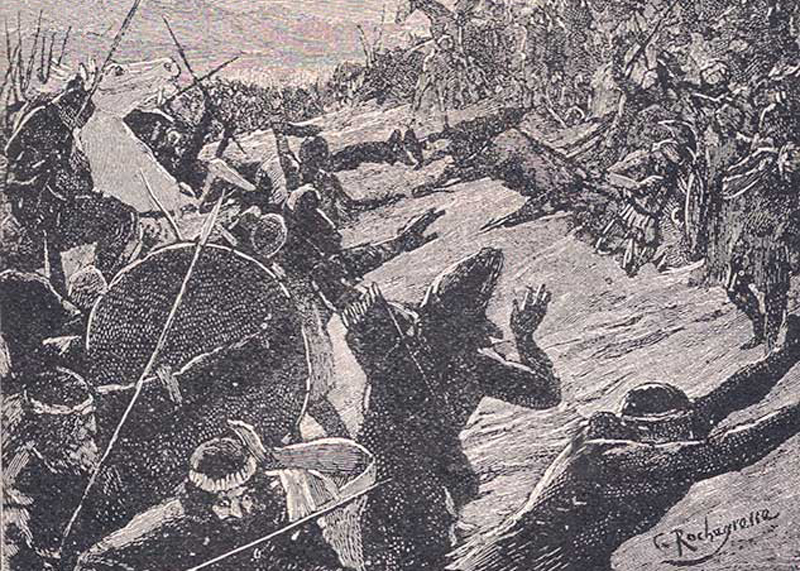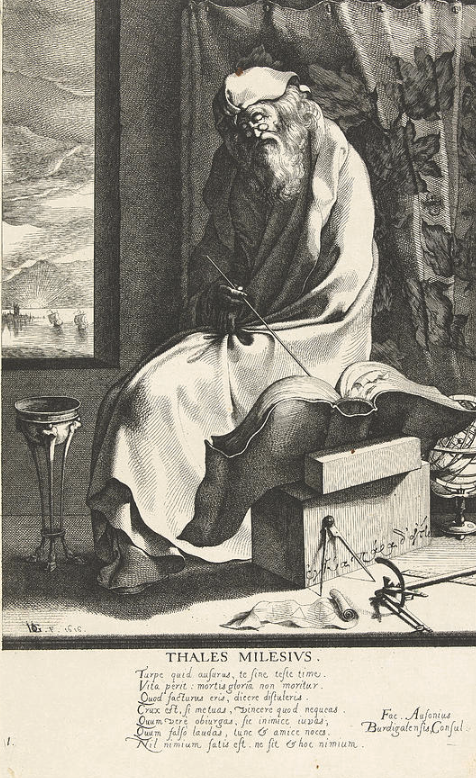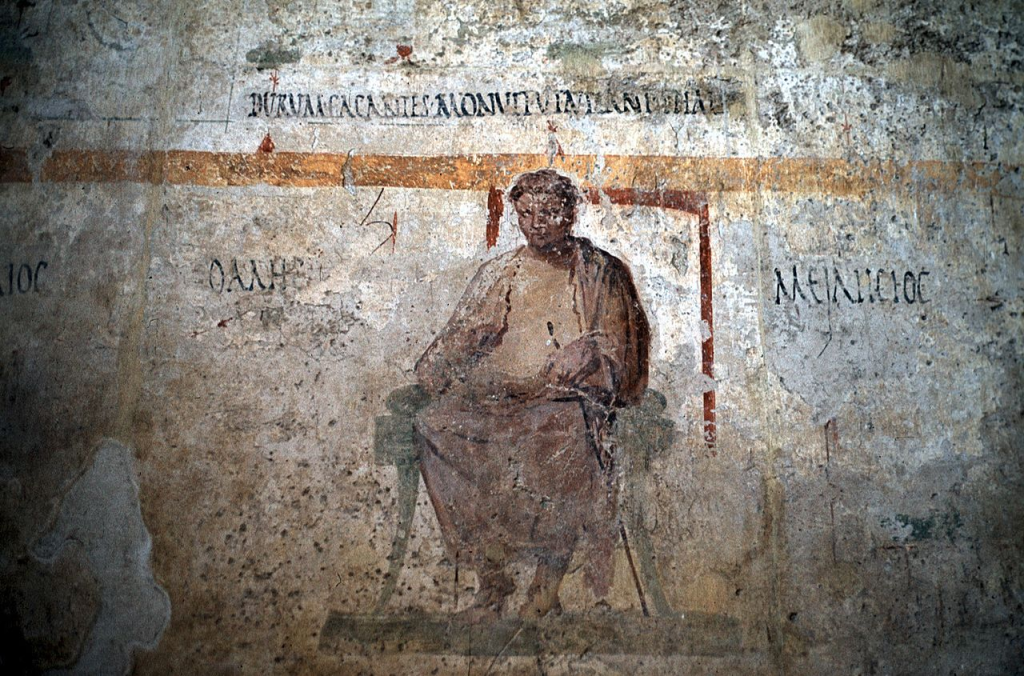Thales of Miletus: The dawn of natural philosophy
Thales of Miletus: The dawn of natural philosophy
- March 18, 2025
- 8:24 pm
- István Csányi
Key Takeaways
-
Thales of Miletus (c. 624-546 BCE) pioneered the transition from mythological to natural explanations of astronomical phenomena.
-
His prediction of the 585 BCE solar eclipse, which ended a war between the Lydians and Medes, marked a turning point in scientific history.
-
Based in the trading hub of Miletus, Thales synthesized astronomical knowledge from Egyptian, Babylonian, and Greek traditions.
-
Thales recognized that moonlight is reflected sunlight, identified the cause of solar eclipses, and improved celestial navigation techniques.
-
The Milesian School, founded by Thales, established a model for knowledge transmission that influenced later scientific institutions.
-
His methodological approach—seeking natural explanations through observation and reason—laid the foundations for all subsequent astronomy.
The Eclipse That Changed History: Thales’ Prediction
On May 28, 585 BCE, as the armies of the Lydians and Medes faced each other on a blood-soaked battlefield in what is now Turkey, something extraordinary happened. The bright afternoon sun began to dim. The light faded, plunging the world into an eerie twilight. Soldiers on both sides lowered their weapons, staring upward in terror as a black disk consumed the sun, its corona shimmering like divine fire around the edges.

The battle ended immediately. The soldiers, interpreting this celestial event as a divine command to cease fighting, laid down their arms. A peace treaty was signed. According to Herodotus, the “Father of History,” Thales of Miletus, one of the earliest presocratic philosophers, predicted this solar eclipse.
Whether Thales predicted this specific eclipse remains debated among historians of ancient Greek astronomy. The Greek astronomer Ptolemy, writing centuries later, doubted that ancient Greeks possessed the mathematical tools for such precise predictions. Modern astronomers have confirmed that a total solar eclipse crossed this region on May 28, 585 BCE, making the story’s core astronomically plausible.
Yet, regardless of its historical accuracy, this story marks a pivotal moment in human history—not just because it ended a war but because it represents the first recorded step in astronomy’s transformation from divine mystery to natural phenomenon.
The Astronomical Reality of the 585 BCE Eclipse
The eclipse would have been a spectacular sight. For approximately two minutes, day turned to night as the moon perfectly aligned with the sun. The solar corona—the sun’s outer atmosphere ordinarily invisible to the naked eye—would have appeared as a shimmering white halo around the dark lunar disk. Stars and planets suddenly became visible in the daytime sky. The temperature would have dropped noticeably, and animals would have begun their nighttime behaviors.
For ancient observers lacking scientific understanding, such an event seemed like nothing less than divine intervention. But with Thales of Miletus, a seed was planted. What if the movements of heavenly bodies weren’t the capricious acts of gods but followed patterns that could be observed, understood, and predicted? This question would eventually revolutionize how humans understood their place in the cosmos.
Thales and the Ancient Port of Miletus: Crossroads of Astronomical Knowledge
To understand Thales and his contributions to ancient Greek astronomy, we must first understand Miletus. In the 6th century BCE, Miletus was a bustling port city on the western coast of Anatolia (modern-day Turkey). It was no quiet backwater but one of the ancient world’s most vibrant commercial and intellectual centers.

Positioned at the mouth of the Maeander River, Miletus served as a crucial bridge between East and West. Its harbors welcomed ships from Greece, Egypt, Phoenicia, and beyond. Merchants unloaded goods and ideas, creating an intellectual marketplace as vibrant as its commercial agora. Knowledge flowed here from all directions—mathematical concepts from Mesopotamia, astronomical observations from Egypt, and navigational techniques from Phoenicia.
Thales himself came from a merchant family, likely of Phoenician descent. Growing up in this cosmopolitan environment, he absorbed diverse intellectual traditions while developing practical skills in navigation and commerce. His merchant activities took him to Egypt and possibly as far as Babylon, exposing him to some of the ancient world’s most advanced astronomical knowledge.
Unlike many of his contemporaries, Thales had the means and opportunity to transform his commercial voyages into journeys of intellectual discovery. In Egypt, he reportedly measured the height of the Great Pyramid by using shadow lengths—applying geometric principles to practical problems. During his travels, he would have encountered Egyptian star charts, Babylonian eclipse records, and practical astronomy used by sailors for navigation.
The Reluctant Olive Oil Tycoon: Practical Applications of Astronomy
One popular story about Thales reveals his practical intelligence and the applications of early astronomical knowledge. Tired of being mocked for his “useless” philosophical pursuits, Thales decided to prove that philosophers could make money if they wished but chose higher pursuits. Using his astronomical observations to predict weather patterns, he anticipated a particularly abundant olive harvest for the coming year. During winter, while prices were low, he secured contracts for all the olive presses in Miletus and the surrounding areas. When harvest time came, and his prediction proved correct, desperate olive growers had to rent presses from Thales at premium rates, earning him a substantial fortune. After demonstrating his point, he reportedly returned to his astronomical and mathematical studies, satisfied that he had proven the practical value of natural philosophy. This anecdote illuminates Thales’ character and the emerging connection between theoretical knowledge and practical application that would become central to scientific development. Another tale paints Thales as the archetypal absent-minded professor. He reportedly fell into a well while walking at night, gazing at the stars. A servant girl who rescued him laughed, saying, “How can you expect to understand what is going on in the sky when you cannot see what is at your feet?” This story, recounted by Plato centuries later, captures the tension between abstract contemplation and practical awareness that has characterized scientific inquiry throughout history.
Water as the First Principle: Thales’ Unified Cosmology
When Thales proposed that water (hydro) was the fundamental substance underlying all creation, he made what might seem like a simple claim today. Yet this proposition represented a revolutionary break from prevailing mythological explanations. Rather than attributing natural phenomena to the whims of anthropomorphic gods, Thales suggested that the cosmos operated according to natural principles that could be understood through observation and reason.
According to Thales’ cosmological model, Earth was a flat disk floating on an infinite cosmic ocean. He believed water could transform into different states—solid, liquid, and vapor—which explained the diversity of matter. While incorrect by modern standards, this theory attempted to explain diverse phenomena through a single unifying principle—a hallmark of scientific thinking.
His water views may have been influenced by his observations during sea voyages: water’s apparent transformation into mist and clouds, the life-giving properties of rainfall, the Nile’s annual flooding, and the sea’s seeming endlessness. He would have encountered creation myths in Egypt featuring primordial waters, while Greek traditions spoke of Oceanus, the river encircling the world. Thales’ innovation was transforming these mythic concepts into naturalistic explanations.
Astronomical Discoveries and Innovations by Thales of Miletus
While much attention is focused on Thales’ cosmological speculations, his practical astronomical contributions are perhaps more significant. According to various classical sources, Thales made several significant contributions to ancient Greek astronomy:
-
Identified the constellation Ursa Minor (the Little Bear) and recognized its importance for navigation, teaching Greek sailors to steer by the North Star rather than the more commonly used but less accurate Ursa Major
-
Divided the year into 365 days and established the solstices as key calendar markers
-
Determined the apparent diameter of the sun as 1/720 of its celestial path
-
Recognized that moonlight is reflected sunlight rather than the moon’s emission
-
Studied the causes of solar eclipses, understanding they occurred when the moon blocked the sun
Navigating by the Lesser Bear: Practical Astronomy
Thales’ recommendation to use Ursa Minor for navigation represented a significant practical advancement for Mediterranean sailors. The constellation’s brightest star, Polaris (the North Star), sits almost directly above the Earth’s north celestial pole, making it an excellent fixed reference point for determining direction.
Unlike the stars in Ursa Major (the Great Bear), who swing in a broader circle around the pole, Polaris remains nearly stationary throughout the night. This distinction might seem minor to modern readers, but this improved accuracy could mean the difference between safe passage and disaster for ancient sailors navigating treacherous waters without compasses.
According to the historian Callimachus, Thales learned about Ursa Minor from Phoenician sailors who were master navigators in the Mediterranean. By introducing this knowledge to Greek mariners, Thales demonstrated his practical approach to knowledge—adopting and disseminating proper techniques regardless of their cultural origin. This navigational improvement facilitated safer long-distance sea travel, enabling greater cultural and intellectual exchange throughout the Mediterranean basin.

Celestial Phenomena Observed by Thales of Miletus
The night sky above Miletus in the 6th century BCE would have been breathtaking by modern standards—free from light pollution and atmospheric contaminants. On clear nights, Thales would have observed:
The Milky Way stretches as a brilliant band across the sky, its structure visible to the naked eye
The planets (known as “wandering stars”) move against the fixed background of constellations
Meteor showers, particularly the Perseids in August, appear as spectacular “falling stars.”
Occasional comets, which were considered omens by many but which Thales likely viewed as natural phenomena
Lunar phases, eclipses, and occultations (when the moon passes in front of a star)
Unlike his contemporaries, who saw these as divine manifestations, Thales sought natural explanations. His understanding that the moon reflects the sun’s light rather than generating its own was particularly insightful, demonstrating his ability to deduce hidden relationships from observable phenomena.
The Milesian School: First Scientific Tradition in Astronomy
Perhaps Thales’ most significant contribution to astronomy wasn’t any single discovery but establishing what would become known as the Milesian School—the West’s first scientific “research program.” By gathering students like Anaximander and Anaximenes, Thales created a community dedicated to exploring natural phenomena through observation and reason.
This approach to knowledge transmission—master to student, with each generation building upon and sometimes challenging previous ideas—would become the template for scientific progress. Anaximander, Thales’ most famous student, proposed that the Earth wasn’t floating on water but suspended freely in space, held in place by its equal distance from all points of the celestial sphere. This remarkable intuition moved closer to our modern understanding.
The Milesian School established several key principles that would define scientific inquiry:
Natural phenomena have natural causes
The universe operates according to consistent principles
These principles can be discovered through observation and reason
Knowledge should be tested and refined over time
This intellectual legacy would flow through subsequent generations of Greek thinkers, influencing Pythagoras, Plato, Aristotle, and eventually, Ptolemy and Hipparchus, whose astronomical works would dominate Western and Middle Eastern understanding for nearly two millennia.
Legacy in Islamic and European Astronomy
Thales helped establish the astronomical tradition, which didn’t end with the classical period but continued to evolve through cultural transmission. When Greek astronomical texts were translated into Arabic during the 8th and 9th centuries CE, Islamic astronomers built upon this foundation, preserving and extending the naturalistic approach Thales had pioneered.
Scholars like al-Battani, al-Biruni, and Ibn al-Haytham refined observational techniques, created more accurate astronomical tables, and developed new instruments for measuring celestial positions with unprecedented precision. These advancements weren’t mere preservation but genuine innovation, all following the methodological path first blazed by Thales.
European science, which later received this knowledge through translations from Arabic, continued this tradition. When Copernicus proposed his heliocentric model in the 16th century—drawing partly on geometric techniques developed by Arab astronomers—he was continuing Thales’s project of seeking natural explanations for celestial phenomena. The line from Thales’ water-borne Earth to our modern understanding of a planet orbiting one star among billions is not straight, but the connecting thread remains unbroken.
Beyond Mythology: The Enduring Revolution in Astronomy
What makes Thales’ contribution revolutionary isn’t that he got everything right—he didn’t—but that he changed how humans approached celestial questions. By suggesting that natural phenomena follow consistent principles discoverable through observation and reason, he helped move astronomy from a religious ritual to a scientific discipline.
When today’s astronomers use sophisticated mathematics to predict eclipses with pinpoint accuracy, launch spacecraft that rendezvous with distant planets or calculate the age of the universe from cosmic microwave background radiation, they are extending the project that Thales began—using careful observation and rational analysis to understand celestial phenomena.
This transition from mythological to natural explanation represents one of the most profound shifts in human thinking. Its effects extend far beyond astronomy to shape our entire scientific worldview. The eclipse that may have ended a war between the Lydians and Medes also heralded the dawn of natural philosophy, a way of understanding the world that would eventually transform human civilization.
Ancient Greek Astronomical Terminology
To better appreciate the language and concepts that developed from Thales’ pioneering work, this brief glossary introduces key terms in ancient Greek astronomy:
Kosmos (κόσμος)
The ordered universe, as opposed to chaos. Thales’ approach suggested that the heavens followed orderly principles rather than divine whims.
Arche (ἀρχή)
The fundamental principle or element. Thales proposed water as the arche of all things, the first attempt at identifying a unifying principle in natural philosophy.
Physis (φύσις)
Nature or the natural order, which Thales sought to understand through observation rather than mythological explanation.
Ouranos (οὐρανός)
Thales studied the heavens or sky, the realm of celestial bodies, through systematic observation.
Astron (ἄστρον)
Star or constellation, objects of Thales’ astronomical observations and navigation techniques.
Planetes (πλανήτης)
Wanderer refers to planets that moved against the fixed star background, a phenomenon Thales recognized as following patterns.
Helios (ἥλιος)
The sun, which Thales recognized as having a measurable size and path through the sky.
Selene (σελήνη)
The moon, which Thales understood, reflected the sun’s light rather than generating its own—a significant insight.
Ekleipsis (ἔκλειψις)
Eclipse is the phenomenon Thales supposedly predicted, demonstrating the regularity of celestial movements.
These terms formed the foundation of the astronomical vocabulary that subsequent cultures would adopt, translate, and expand, including Arab astronomers who preserved many Greek concepts while adding their own terminology and insights.
Frequently Asked Questions About Thales of Miletus
How did Thales predict the 585 BCE solar eclipse?
While the historical accounts claim Thales predicted the eclipse, modern historians debate whether he could have made such a precise prediction with the mathematical tools available. It’s more likely he recognized patterns in eclipse cycles based on Babylonian records, allowing him to predict that an eclipse would occur within a specific period rather than the exact day and location.
What was Thales’ most significant contribution to astronomy?
Thales’ most significant contribution was methodological. He introduced the approach of seeking natural rather than supernatural explanations for celestial phenomena. His practical contributions included improving navigation by recommending Ursa Minor, recognizing that moonlight is reflected sunlight, and understanding the basic mechanics of solar eclipses.
Why is Thales considered the first philosopher in the Western tradition?
Thales is regarded as the first philosopher because he was the first recorded figure to propose natural explanations for the world’s phenomena instead of mythological ones. By suggesting water as the fundamental principle (arche) of all things, he initiated the search for underlying natural principles that define philosophy and science.
How did Thales influence later astronomers?
Thales established a methodology and tradition of natural inquiry, which his students Anaximander and Anaximenes followed, eventually being followed by figures like Pythagoras, Aristotle, Hipparchus, and Ptolemy. His approach to knowledge transmission through a school of thought became the model for scientific institutions throughout history.
What evidence do we have about Thales’ astronomical knowledge?
We have no direct writings from Thales himself. Our knowledge comes from later sources, primarily Aristotle and his commentators, Diogenes Laertius, Plutarch, and others who wrote about him centuries after his death. This makes it difficult to separate historical facts from later embellishments.
The next time you look at the night sky, remember Thales of Miletus—not as a perfect scientist but as someone who dared to suggest that the luminous bodies above followed patterns that human minds could comprehend. In that intellectual leap from divine mystery to natural phenomenon, he helped humanity take its first steps toward understanding our place in the cosmos.
Academic References
O’Grady, P. F. (2017). Thales of Miletus: The Beginnings of Western Science and Philosophy. Routledge.
Özel, M. E. (2011). “A Unique Astronomical Heritage Place: The May 28, 585 BCE Solar Eclipse.” IAU Symposium Proceedings, 260.
Müllenhoff, M., et al. (2009). “Geoarchaeology in the City of Thales: Deciphering Palaeogeographic Changes in the Agora Area of Miletos.” Mensch und Umwelt im Spiegel der Zeit, 97–110.
Dicks, D. R. (1959). “Thales.” Classical Quarterly, 9(2): 294–309.
Boyer, C. B. (1968). A History of Mathematics. Wiley.
Kirk, G. S., Raven, J. E., & Schofield, M. (1983). The Presocratic Philosophers. Cambridge University Press
In our next post, we’ll explore how the Antikythera Mechanism—an ancient Greek astronomical computer discovered in a shipwreck—represents the mechanical embodiment of astronomical knowledge. We will show how theoretical understanding transformed into technological innovation centuries before the modern era.

Business Development at Machine Intelligence Zrt. Innovation professional with 25+ years of experience in IT solutions and product strategy. Science history enthusiast and digital fabrication hobbyist specializing in 3D printing, laser cutting, and CNC. Holds MSc degrees in Chemistry and Physics from the University of Szeged.



